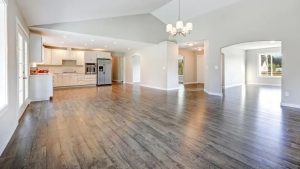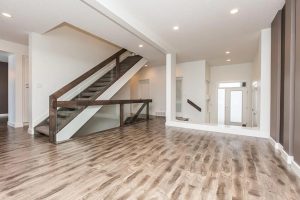Flooring is the foundation (pun intended) of any home. It sets the aesthetic tone, influences comfort underfoot, and needs to withstand the daily wear and tear of life. With a plethora of flooring options available, choosing the right one can feel overwhelming. This comprehensive guide delves into the world of home flooring, equipping you with the knowledge to make an informed decision for your space.
Understanding Your Needs:
Before diving into specific materials, it’s crucial to understand your needs and priorities. Here are some key factors to consider:
- Room Usage: High-traffic areas like kitchens and hallways require durable flooring that can handle spills and constant foot traffic. Bedrooms and living rooms can accommodate softer, more comfortable options.
- Lifestyle: Do you have pets or young children? Opt for stain-resistant and easy-to-clean flooring materials.
- Budget: Flooring costs vary significantly. To reduce your alternatives, decide on your budget in advance.
- Climate: Consider your local climate. Hardwood floors might not be ideal for humid areas, while tile might feel cold in colder climates.
- Personal Style: Flooring plays a major role in a room’s aesthetics. Choose a material that complements your overall design style.
Exploring the Flooring Frontier: Popular Options and Their Perks
Now that you have a clearer picture of your needs let’s explore some popular flooring options:
-
Hardwood Flooring:
The timeless beauty of hardwood floors adds elegance and warmth to any space.
- Pros: Durable, long-lasting, increases home value, easy to clean.
- Cons: Requires regular maintenance, can be susceptible to scratches and dents, not ideal for high-moisture areas.
-
Engineered Hardwood:
A more affordable alternative to solid hardwood, it offers a similar look and feel to a plywood core.
- Pros: More resistant to moisture than solid hardwood, a wider variety of finishes and styles.
- Cons: Solid hardwood is more durable; the top layer can be scratched.

-
Laminate Flooring:
Budget-friendly and easy to install, laminate offers the look of wood or stone at a fraction of the cost.
-
Pros:
Easy to clean and maintain, scratch-resistant, wide variety of styles and colours.
-
Cons:
Not as durable as hardwood, can feel hollow underfoot, susceptible to water damage if not installed correctly.
-
-
Tile Flooring:
A versatile and durable option, tile comes in various materials like ceramic, porcelain, and natural stone.
- Pros: Waterproof, easy to clean, fire-resistant, vast array of styles and colours.
- Cons: It can be cold underfoot, grout lines require regular cleaning, and some materials are prone to chipping or cracking.
-
Vinyl Flooring:
Resilient and affordable, vinyl flooring comes in various forms, including luxury vinyl planks (LVP) and luxury vinyl tiles (LVT).
- Pros: Waterproof, comfortable underfoot, easy to install and maintain, wide variety of styles and textures.
- Cons: Can be susceptible to tears and punctures, some lower-quality options may emit VOCs (volatile organic compounds).
-
Carpet:
Soft, comfortable, and offering excellent sound insulation, the carpet creates a warm and inviting atmosphere.
- Pros: Affordable, comfortable underfoot, good sound insulation, variety of colours and textures.
- Cons: Requires regular cleaning and maintenance, can trap allergens, may not be ideal for allergy sufferers.
-
Cork Flooring:
An eco-friendly and sustainable option, cork flooring offers a unique look and feel.
- Pros: Warm underfoot, comfortable, sound-insulating, naturally hypoallergenic.
- Cons: It can be susceptible to moisture damage, requires special cleaning products, and has limited availability in certain regions.
Beyond the Basics: Additional Considerations
While material selection is crucial, consider these additional factors:
- Underlayment: This layer installed beneath the flooring provides cushioning, moisture protection, and sound insulation.
- Installation: Professional installation is recommended for some flooring materials like hardwood and tile.
- Maintenance: Different flooring materials require specific cleaning and maintenance routines. Factor maintenance needs into your decision.
- Sustainability: If eco-friendly practices are a priority, consider sustainable options like cork, bamboo, or recycled content carpets.

Flooring for Every Footfall: Choosing the Right Option for Each Room
Here’s a quick guide to choosing the right flooring for different rooms in your home:
- Living Room: Engineered hardwood, laminate, LVP, or carpet are all suitable options.
- Kitchen and Dining Room: Tile, LVP, or luxury vinyl sheet flooring are ideal choices due to their water resistance and ease of cleaning. Consider textured options for high-traffic areas to minimize the appearance of scuffs.
- Bathroom: Ceramic or porcelain tile offers superior water resistance and durability. Look for slip-resistant options for safety.
- Bedrooms: The carpet provides warmth and comfort underfoot. Consider hypoallergenic options for allergy sufferers. Hardwood or laminate can also work well.
- Entryway: Durable and easy-to-clean options like tile, LVP, or laminate are ideal for handling dirt, debris, and moisture tracked in from outside.
Conclusion
Flooring is a significant investment, so choose wisely. By considering your needs, lifestyle, and budget, you can select the perfect flooring that enhances the beauty, functionality, and value of your home for years to come. Remember, to create a room that reflects your style and personality, don’t be afraid to experiment with different textures, colours, and patterns. Happy flooring!
